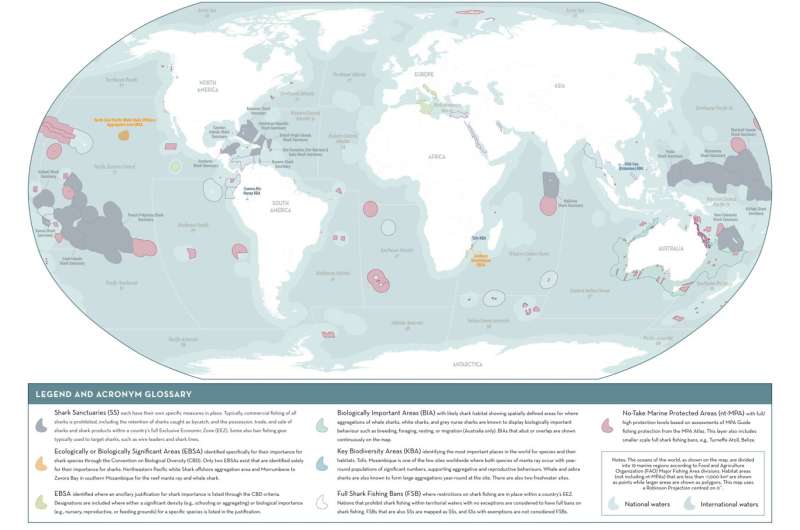Putting sharks on the map: A new standard to identify important habitats

To date, shark, ray, and chimaera species have not been sufficiently considered in the planning of marine protected areas. However, a publication in Frontiers in Marine Science by researchers from the IUCN SSC Shark Specialist Group, IUCN’s Ocean Team, and the IUCN Marine Mammal Protected Areas Taskforce have developed a new framework to fundamentally change how sharks are considered in the design of protected areas and therefore support the protection they desperately need in the face of extinction.
Ciaran Hyde, Consultant to the IUCN Ocean Team, explained, “We still have so much to learn about many shark, ray, and chimaera species, but unfortunately several studies indicate that many protected areas are failing to adequately meet their needs. However, Important Shark and Ray Areas (ISRAs) will help to identify areas for these species using criteria which have been specifically designed to consider their biological and ecological needs.”
As apex predators, sharks provide many vital functions for maintaining a balanced ecosystem. Sharks shape fish communities, ensure a diversity of species, and even help our oceans sequester more carbon by maintaining seagrass meadows.
“Losing sharks, rays and chimaeras will not only affect the health of the entire ocean ecosystem, but also impact food security in many countries,” highlighted Lynn Sorrentino, IUCN Ocean Team Program Officer.
However, their apex status makes them more susceptible to anthropogenic threats. Many of these species are impacted by fishing, especially in tropical and coastal areas where large communities live along the coast and depend upon fish as their main source of protein.
As Dr. Rima Jabado, Chair of the IUCN SSC Shark Specialist Group explained. “Sharks are a long-lived species: Many take a long time to reach sexual maturity and then only give birth to a few young. This makes them particularly susceptible to fishing pressure and with an estimated 37% of species with an elevated risk of extinction, they are facing a biodiversity crisis. Results from the ISRA project will inform policy and ensure that areas critical to the survival of sharks, rays, and chimaeras are considered in spatial planning.”
Developed by experts, conservation agencies, and governments
Work on the ISRA Criteria was developed through a collaborative process involving shark experts, conservation agencies, and governments and include four criteria and seven sub-criteria. These consider the complex biological and ecological needs of sharks, including areas important to threatened or range-restricted species, the specific habitats that support life-history characteristics and vital functions (e.g., reproduction, feeding, resting, movement), distinctive attributes, and the diversity of species within an area.
Dr. Giuseppe Notarbartolo di Sciara, co-chair of the IUCN Marine Mammal Protected Areas Taskforce and Deputy Chair of the IUCN SSC Cetacean Specialist Group, noted, “All efforts are being made to ensure that the ISRAs contain the best and most up-to-date place-based information that science can offer to decision makers, managers, and marine users. As the ISRA program proceeds by covering progressively the whole extent of the ocean (and relevant inland water) surface, a very broad involvement of the shark expert community worldwide is expected.”
By bringing together information from scientific publications, reports, databases and the expertise of individual shark experts, ISRAs are a powerful tool for governing bodies to develop policy and design protected areas.
Endangered sharks, rays caught in protected Med areas: study
Putting sharks on the map: a global standard for improving shark area-based conservation, Frontiers in Marine Science (2022). DOI: 10.3389/fmars.2022.968853
Citation:
Putting sharks on the map: A new standard to identify important habitats (2022, September 13)
retrieved 13 September 2022
from https://phys.org/news/2022-09-sharks-standard-important-habitats.html
This document is subject to copyright. Apart from any fair dealing for the purpose of private study or research, no
part may be reproduced without the written permission. The content is provided for information purposes only.
For all the latest Science News Click Here
For the latest news and updates, follow us on Google News.

